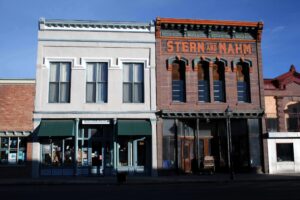After the National Historic Preservation Act of 1966 was adopted, New Mexico established historic districts in Spanish colonial neighborhoods, territorial boomtowns, American downtowns, eastern plains and oil patch towns. These districts preserve the best of New Mexico’s architectural landmarks.
- Posts: 34 -
Alameda Depot Historic District

Constructed 1881. At the turn of the century, Las Cruces was not unlike any other thriving small town. The railroad, which was completed in 1881, created a stir in what would become the downtown area of the City of the Crosses, bringing with it people, jobs and architecture. It was Read more…
Artesia Residential Historic District
Constructed 1904. With mature trees shading many of its streets, a public park improved by the Works Progress Administration (WPA), and its early and mid-twentieth century building stock, Artesia’s historic residential district retains its original gracious character and integrity. Architecturally Artesia was influenced by the proximity of the railroad as Read more…
Barelas 4th Street Historic District

Barelas is an inner-city neighborhood of Albuquerque located immediately south of downtown. It consists of the triangular area bounded by Coal Avenue, the BNSF railroad tracks, and the Rio Grande. Originally a separate village, it was absorbed into Albuquerque during the railroad fueled growth of the 1880s but still retains Read more…
Bridge Street Historic District

Constructed 1890 Located on a downhill slope between the Plaza and the Gallinas River, what is now Bridge Street was originally the National Road or the Santa Fe Trail before the railroad arrived. This area was where the original settlements gardens and acequia madre (mother ditch) were located. As the Read more…
Carlsbad Downtown Historic District

Constructed 1892. Located along the banks of the Pecos River, Carlsbad was originally christened the Town of Eddy on September 15, 1888 and organized as a municipality in 1893. With the improvement of the mineral springs north of town, and their valuable medicinal qualities, the town changed the name to Read more…
Carnegie Park Historic District

The Carnegie Park Historic District is listed on the state and national registers and preserves the architectural fabric and eclecticism of the Gilded Age in New Mexico. With the boomtown prosperity of the railroad economy, Las Vegas attracted many prosperous merchants and entrepreneurs, some of whom made their homes near Read more…
Chihuahua Hill Historic District

Constructed 1880. The small adobe chapel “La Capilla” overlooks Silver City’s oldest residential neighborhood, Chihuahua Hill. The neighborhood evolved from a tent city in the 1870s shortly after the town was founded. The discovery of silver and copper in the vicinity caused boomtown growth and the railroad’s arrival in the Read more…
Clayton Commercial Historic District

Constructed 1920. In the late 1880s talk of a railroad was heard and Stephen W. Dorsey, who had built a mansion at Mountain Spring about 60 miles west of Clayton, acquired access to the site where Clayton was eventually situated. A town site was laid out, named after Dorsey’s son Read more…
Clovis Railroad and Commercial Historic District

Constructed 1930. In October of 1906, railroad officials bought 640 acres of land, and on April 13, 1907 they filed the Clovis town site plat. Railroad facilities, including a large roundhouse, machine shops, offices for division personnel, and a Harvey Hotel, were established at the south end of Main Street. Read more…
Couse Pasture

Constructed 1930. The Couse pasture and house gardens together interpret open horse pasture lands neat the plaza and also a cultivated garden of one the Taos communities leading art families. Bucolic pastures with magnificent mountain views are common in the Taos valley, but the Couse pasture is distinctive for its Read more…